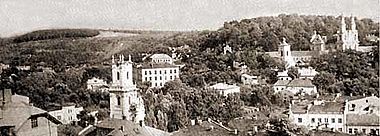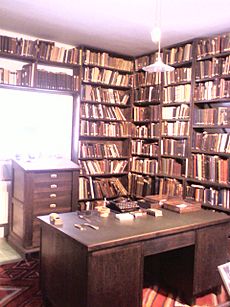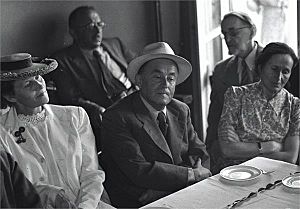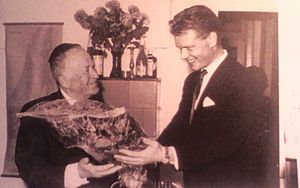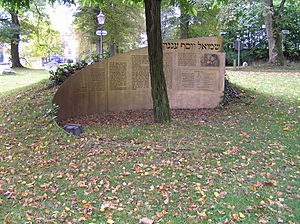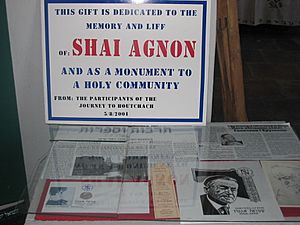Shmuel Yosef Agnon facts for kids
Quick facts for kids
Shmuel Yosef Agnon
|
|
|---|---|
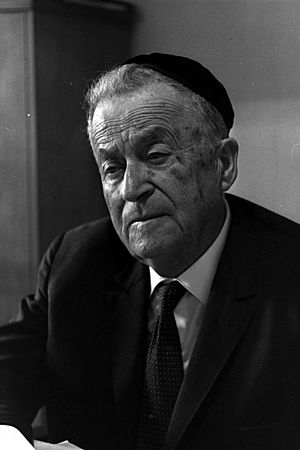
Agnon in 1966
|
|
| Born | Shmuel Yosef Halevi Czaczkes July 17, 1888 Buczacz, Austria-Hungary (now Buchach, Ukraine) |
| Died | February 17, 1970 (aged 81) Jerusalem, Israel |
| Resting place | Mount of Olives Jewish Cemetery |
| Occupation | writer |
| Language | Hebrew |
| Nationality | Israeli |
| Genre | Novels |
| Notable awards | Nobel Prize in Literature 1966 |
| Spouse | Esther Marx |
Shmuel Yosef Agnon (Hebrew: שמואל יוסף עגנון; July 17, 1888 – February 17, 1970) was a very important writer in modern Hebrew literature. Many people know him by his short name, Shai Agnon (ש"י עגנון). In English, his books are published as S. Y. Agnon.
Agnon was born in a part of Poland called Galicia. This area was then part of the Austro-Hungarian Empire. Later, he moved to Mandatory Palestine, which is now Israel. He passed away in Jerusalem.
His stories often explore the differences between traditional Jewish life and the modern world. He also tried to capture the old traditions of European shtetls (small Jewish villages). Agnon had a special way of writing. He mixed modern Hebrew with older, religious Hebrew.
In 1966, he won the Nobel Prize in Literature. He shared this big award with a poet named Nelly Sachs.
Contents
Who Was Shmuel Yosef Agnon?
Shmuel Yosef Halevi Czaczkes was his birth name. He later changed it to Agnon. He was born in a town called Buczacz (now in Ukraine). Officially, his Jewish birthday was July 26, 1888. But he always said it was on Tisha B'Av, a Jewish fast day.
His father, Shalom Mordechai Halevy, was a rabbi. He also worked in the fur trade. His mother's family had ties to a different Jewish group called the Misnagdim.
Agnon did not go to a regular school. His parents taught him at home. He studied Jewish texts and also learned German. He started writing in Hebrew and Yiddish when he was only eight years old. At 15, he published his first poem.
In 1908, he moved to Jaffa in Ottoman Palestine. His first story there was "Agunot" ("Forsaken Wives"). He used the pen name "Agnon" for this story. He liked it so much that he made it his official last name in 1924.
Life in Germany and Return to Jerusalem
In 1913, Agnon moved to Germany. There, he met Esther Marx, and they married in 1920. They had two children together. While in Germany, a rich businessman named Salman Schocken became his supporter. This meant Agnon didn't have to worry about money. Schocken later published all of Agnon's books.
In 1924, a fire destroyed Agnon's home. He lost many of his writings and rare books. This sad event sometimes appears in his stories. Later that year, Agnon moved back to Palestine. He settled with his family in Jerusalem. In 1929, his library was destroyed again during riots.
Agnon became very famous in Hebrew literature in 1931. That's when his novel Hachnasat Kalla ("The Bridal Canopy") came out. He also wrote Sippur Pashut ("A Simple Story") in 1935. Another important novel, Tmol Shilshom ("Only Yesterday"), was published in 1945.
Agnon was a vegetarian in his daily life.
What Did Agnon Write About?
Many experts have studied Agnon's writing. He wrote about Jewish life, but in his own special way. In his Nobel Prize speech, Agnon said his main influences were stories from the Bible. He also learned from German and other European literature.
The places he lived in also inspired his books:
- Galicia: You can see this in books like The Bridal Canopy and A Guest for the Night.
- Germany: Stories like "Fernheim" and "Between Two Cities" are set there.
- Jaffa: "Oath of Allegiance" and "Tmol Shilshom" take place here.
- Jerusalem: "Tehilla" and "Shira" are set in Jerusalem.
Some of Agnon's works have even been turned into theatre plays.
Agnon's Unique Language
Agnon's writing style was special. He often used words and phrases that were different from modern Hebrew. His language came from old Jewish texts. These include the Torah, the Prophets, Midrashic writings, and the Mishnah.
Here are some examples of his unique words:
- batei yadayim (meaning "hand-houses") instead of modern kfafot (gloves).
- yatzta (יצתה) instead of the modern yatz'a (יצאה) ("she went out").
- rotev (רוטב) for soup, while in modern Hebrew it means 'sauce'.
- bet kahava for a coffee house, instead of the modern bet kafe.
Bar-Ilan University has even created a special computer program to study his language.
Awards and Recognition
Agnon won the Bialik Prize for literature twice (in 1934 and 1950). He also won the Israel Prize for literature twice (in 1954 and 1958).
In 1966, he received the Nobel Prize in Literature. The prize was given to him "for his deeply unique storytelling about the life of the Jewish people." He shared the award with German Jewish author Nelly Sachs.
At the award ceremony, Agnon said in Hebrew: "Because of the terrible event when Titus of Rome destroyed Jerusalem and Israel was sent away from its land, I was born in one of the cities of exile. But I always felt like I was born in Jerusalem." The ceremony was on a Saturday during the Jewish holiday of Hanukkah. Agnon was very religious. He waited to attend the ceremony until he had finished two Jewish ceremonies on Saturday night. These were to end the Sabbath and to light the menorah.
Later in his life, Agnon was so famous that when he complained about traffic noise near his home, the city closed the street to cars! They even put up a sign that said: "No entry to all vehicles, writer at work!"
Agnon's Legacy
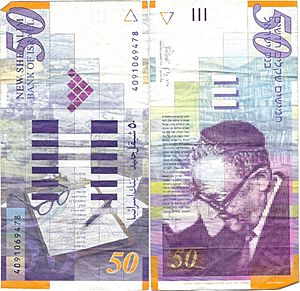
Agnon passed away in Jerusalem on February 17, 1970. His daughter, Emuna Yaron, has continued to publish his works after his death. Agnon's writings were given to the National Library in Jerusalem.
His home in Talpiot, Jerusalem, was built in 1931. It was designed in the Bauhaus style. Today, it is a museum called Beit Agnon. His study, where he wrote many of his books, looks exactly as it did when he was alive.
Agnon's picture, along with a list of his works and his Nobel Prize speech, was on the fifty-shekel bill from 1985 to 2014. A main street in Jerusalem is named Sderot Shai Agnon. There is also a synagogue near his home named after him.
Agnon is also remembered in his hometown of Buchach, Ukraine. There is a museum exhibition about him there. A statue of Agnon stands across the street from the house where he grew up. The street in front of his house is even called "Agnon Street."
A special method called Agnotherapy was developed in Israel. It helps older people express their feelings.
Beit Agnon: His Home as a Museum
After Agnon died, the former mayor of Jerusalem, Mordechai Ish-Shalom, wanted to open his home to the public. In the early 1980s, parts of the house became a place for lectures and cultural events.
In 2005, the Agnon House Association in Jerusalem renovated the building. It reopened in January 2009. A German-Jewish architect named Fritz Korenberg designed the house. He was also Agnon's neighbor.
Agnon's Published Works
Novels and Novellas
- The Bridal Canopy (1931): This epic story describes Jewish life in Galicia in the early 1800s. It follows a poor but religious Jewish man, Reb Yudel, as he searches for husbands for his three daughters.
- In the Heart of the Seas, a story of a journey to the land of Israel (1933): A short novel about ten men traveling from Eastern Europe to Jerusalem.
- A Simple Story (1935): This short novel is about a young man looking for a wife and what he learns about marriage.
- A Guest for the Night (1938): This novel shows the decline of Jewish life in Eastern Europe. The narrator visits his old hometown and sees how much it has changed since World War I.
- Betrothed (1943): A short novel.
- Only Yesterday (1945): An epic novel set in Israel in the early 1900s. It follows the narrator from Galicia to Jaffa and then to Jerusalem.
- Edo and Enam (1950): A short novel.
- To This Day (1952): A story about a young writer stuck in Berlin during World War I.
- Shira (1971): This novel is set in Jerusalem in the 1930s and 1940s. It's about a professor named Manfred Herbst who searches for a nurse named Shira.
Short Stories
- Of Such and Of Such: A collection including "And the Crooked Shall Be Made Straight" and "Forsaken Wives."
- At the Handles of the Lock (1923): Love stories like "A Simple Story" and "The Dune."
- Near and Apparent: Stories like "The Lady and the Peddler" and "Introduction to the Kaddish."
- Thus Far: Includes "Prayer," "Oath of Allegiance," and "Fernheim."
- The Fire and the Wood: A collection of Hasidic tales and stories about Agnon's family.
- Tale of the Goat
English Translations
Many of Agnon's works have been translated into English, making them available to readers worldwide. Some examples include:
- A Simple Story, translated by Hillel Halkin.
- Shira, a revised edition of his last novel.
- Two Tales: Betrothed & Edo and Enam.
- Twenty-One Stories, a collection from "The Book of Deeds."
- A Dwelling Place of My People, with 16 short stories about the Hassidim of Poland.
Anthologies (Collections of Writings)
- Days of Awe (1938): A book about customs and legends for Jewish holidays like Rosh Hashanah and Yom Kippur.
- Present at Sinai: The Giving of the Law (1959): A collection for the festival of Shavuot.
Books Published After His Death
- Ir Umeloah ("A City and the Fullness Thereof") (1973): Stories and legends about Buczacz, his hometown.
- In Mr. Lublin's Store (1974): Set in Germany during World War I.
- Within the Wall (1975): A collection of four stories.
- From Myself to Myself (1976): Essays and speeches.
- Introductions (1977): More stories.
- Book, Writer and Story (1978): Stories about writers and books from Jewish sources.
- The Beams of Our House (1979): Two stories, one about a Jewish family in Galicia, the other about Agnon's family history.
- Esterlein Yakirati ("Dear Esther: Letters 1924–1931" (1983): Letters from Agnon to his wife.
- A Shroud of Stories (1985).
- The Correspondence between S.Y. Agnon and S. Schocken (1991): Letters between Agnon and his publisher.
- Agnon's Alef Bet Poems (1998): A children's guide to the Hebrew Alphabet.
- A Book That Was Lost: Thirty Five Stories (2008).
In 1977, the Hebrew University published Yiddish Works. This was a collection of stories and poems Agnon wrote in Yiddish between 1903 and 1906.
See also
 In Spanish: Shmuel Yosef Agnón para niños
In Spanish: Shmuel Yosef Agnón para niños
- List of Israel Prize recipients
- List of Bialik Prize recipients
- List of Israeli Nobel laureates
- List of Jewish Nobel laureates
- List of Polish Jews
- List of Galician Jews


